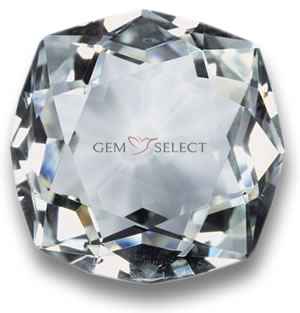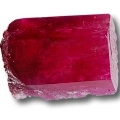Goshenite Gemstone Information

Buy Goshenite Gemstones
About Goshenite - History and Introduction
Goshenite belongs to the beryl group of minerals, which are beryllium aluminum silicates. Beryl can occur in a wide range of colors, including green, blue, pink, golden, red and white or colorless as with goshenite. Technically, goshenite is the purest form of beryl, since it lacks coloring agents and impurities that are responsible for giving gemstones their color. The beryl family is most famous for emerald and aquamarine, as well as morganite, heliodor, golden beryl and bixbite.
Goshenite was first discovered in the small town of Goshen, located in Hampshire County of Western Massachusetts. Today, goshenite and other deposits of beryl, can be found all around the world. Before the introduction of synthetic diamonds, goshenite was often used as a diamond alternative. By the placement of silver or green foil under the stone, goshenite can even be used as alternatives for emeralds and other precious colored stones. The colored foil enhances goshenite's color similar to the way 'coating' can enhance mystic quartz or topaz.
Goshenite was once used for the manufacturing of eyeglasses, because of its excellent transparency. Goshenite is also considered an excellent source for beryllium. Goshenite, like all beryl, has excellent hardness, durability and toughness. It is very resistant to corrosive materials, but goshenite is considered to be quite brittle and sensitive to pressure.
There are a number of different gems that closely resemble goshenite, including quartz, white topaz, white zircon and white sapphire. However, beryl can usually be easily distinguished from other similar gems through basic testing. One of the easiest testing methods to identify goshenite is by testing for specific gravity (density) and hardness. Goshenite is significantly harder than quartz and feldspar, but slightly softer than topaz and sapphire. Beryl, topaz and sapphire all have very different crystal structures, making beryl quite distinct due to its unique six-sided hexagonal crystal formation.
Although goshenite is named after the small town of Goshen, Massachusetts, it can be found all over the world including North and South America, China, Canada, Russia, Mexico, Colombia, Brazil, Northern Europe, Africa and Asia. It is thought that the largest, cleanest and best quality material is found in Brazil.
Buying Goshenite and Determining Goshenite Value Back to Top
Goshenite Color
Goshenite is sometimes referred to as white or colorless beryl. It is the transparent, colorless and alkali-bearing variety of beryl. It is often confused with other white or colorless gemstones like quartz, topaz, zircon and sapphire. It can be confused with diamond, but due to the lack of fire, dispersion and hardness, it is easily distinguishable from much more valuable diamond.
Goshenite Clarity and Luster
Goshenite is a colorless transparent gem-quality beryl. Most goshenite gems are very 'clean' and lack inclusions unlike emerald. When cut and polished, goshenite has a waxy to vitreous luster. Beryl clarity can range from transparent to opaque, but only transparent material is used for gemstones. Goshenite has an indistinct cleavage that runs parallel to the basal pinacoid, and because of this, gem cutters will typically cut the gem to minimize cleavage, and to ensure durability and maximum luster.
Goshenite Cut and Shape
Goshenite is most often faceted for gem collectors rather than for jewelry, but fine jewelry can still be found. Goshenite is very durable, like all beryl, so it can be cut into any shape or style and it's quite suitable for use in mainstream jewelry owing to its excellent gemstone affordability. Goshenite is not often finished as gemstone cabochons, and unlike emerald, it is not usually found in step-cut style.
Goshenite Treatment
Goshenite is typically untreated, mainly because it is relatively available and affordable. Despite its abundance, top quality and premium-sized goshenite specimens can fetch very high prices. Goshenite is sometimes treated to produce bright and vivid colors through irradiation treatment, but this treatment should always disclosed by reputable gem dealers. Some goshenite can be color and dispersion-enhanced through the use of silver and other colored foil lining.
| Chemical Formula: |
AI2Be3SI6O18 |
| Crystal Structure: |
Hexagonal, hexagonal prisms |
| Color: |
White, colorless |
| Hardness: |
7.5 to 8 on the Mohs scale |
| Refractive Index: |
1.562 to 1.602 |
| Density: |
2.67 to 2.78 |
| Cleavage: |
Indistinct |
| Transparency: |
Transparent to opaque |
| Double Refraction / Birefringence: |
-0.0004 to -0.0013 |
| Luster: |
Waxy to vitreous |
| Fluorescence: |
Usually none |
Please refer to our Gemstone Glossary for details of gemology-related terms.
 |
| Bixbite - Red Beryl |
Beryl is a very large group of minerals. There are several closely related gemstone varieties of goshenite, typically classified by color and impurities within. There are also many similar-looking gemstones, such as white zircon, quartz, topaz, sapphire and even diamond. However, gems that are close in appearance can be easily identified by testing for hardness and crystal formation.
Most Popular Goshenite Varieties:
Emerald, aquamarine, morganite, golden beryl and precious beryl are the most popular varieties of goshenite.
Lesser-Known Goshenite Varieties:
Bazzite, bixbite, green beryl (not emerald) and pezzottaite are the rarest and lesser-known varieties of goshenite.
Goshenite Gemstone Mythology, Metaphysical and Alternative Healing Back to TopGoshenite is said to bring clarity and truth into one's life and bring balance to the wearer, bringing the physical body into tune with the psychic mind. It is thought to discourage infidelity and promote sincerity. Goshenite was referred to in ancient Irish scriptures, with regard to its importance and popularity as a divining tool, much preferred over other traditional Irish divining tools. Precious beryl in general promotes luck, energy and youthfulness. Goshenite is a friendship gem.
Goshenite is a stone of wisdom, that can spark intellectual thoughts and curiosity in its wearer. Perhaps goshenite's historical use as lenses in eye glasses has caused it to be associated with vision and intelligence. Goshenite is believed to help people to see situations from different perspectives, reinforcing sight and vision. Goshenite represents purity and is a stone of truth; it is transparent and nothing can be hidden within. Goshenite is a stone of Gemini. It enhances the energies of all chakras and is known as a balancing stone. It is the stone of the moon and associated with the element of water in both Eastern and Western crystal power philosophy.
| Disclaimer: Metaphysical and Alternative Crystal Healing Powers and Properties are not to be taken as confirmed advice. Traditional, Ceremonial and Mythological Gemstone Lore is collected from various resources and is not the sole opinion of SETT Co., Ltd. This information is not to replace the advice of your doctor. Should you have any medical conditions, please see a licensed medical practitioner. GemSelect does not guarantee any claims or statements of healing or astrological birthstone powers and cannot be held liable under any circumstances. |
Goshenite Gemstone and Jewelry Design Ideas Back to TopBeryl is an excellent gemstone for any type of jewelry application. Goshenite and other beryl gemstones are typically available in larger sizes and are very affordable compared to other gemstones (with exception to precious green emerald). Goshenite is best set into designs that allow light to pass through easily and they are excellent as diamond substitutes. Before the introduction of diamond simulants such as cubic zirconia, goshenite was actually one of the most popular diamond replacements. Goshenite's fire and brilliance was enhanced through silver foil-lining.
Beryl in general is one of the most popular gemstones in the world and a favorite among jewelers, not only for its superior hardness and durability, but also because of its affordability, beauty and color diversity. Goshenite is not typically found in local jewelry stores, even though other beryls such as aquamarine and emerald are two of the most popular gemstones. Goshenite can be used for fashion earrings, pins, brooches, rings (including engagement rings), cuff links, tie tacks and much more. Goshenite is an excellent material for gemstone carvings and ornaments.
Note: Buy colored gemstones by size and not by carat weight. Colored stones vary in size-to-weight ratio. Some stones are larger and others are smaller than diamond in weight comparison.
Goshenite Gemstone and Jewelry Care and Cleaning Back to Top All beryl gemstones are sensitive to pressure and extremely vulnerable to household chemicals, especially green emerald. Although beryl is one of the more durable gem types, it does require some care. Avoid wearing beryl jewelry when using harsh chemicals like bleach or sulfuric acid. Use warm soapy water and a soft cloth to clean your beryl stones. Be sure to rinse well to remove all soapy residue. As with most other gemstones, avoid the use of ultrasonic cleaners, as well as heat steamers. All beryl gemstones are sensitive to pressure and extremely vulnerable to household chemicals, especially green emerald. Although beryl is one of the more durable gem types, it does require some care. Avoid wearing beryl jewelry when using harsh chemicals like bleach or sulfuric acid. Use warm soapy water and a soft cloth to clean your beryl stones. Be sure to rinse well to remove all soapy residue. As with most other gemstones, avoid the use of ultrasonic cleaners, as well as heat steamers.
Take off and remove beryl jewelry before exercising, cleaning or engaging in vigorous physical activities. Beryl can easily scratch other gems and at the same time, be easily scratched, so try to avoid contact with other gems. Always store goshenite gemstones separately from other stones. Wrap them in soft cloth and place them into a fabric-lined box when storing them for long periods of time. |
